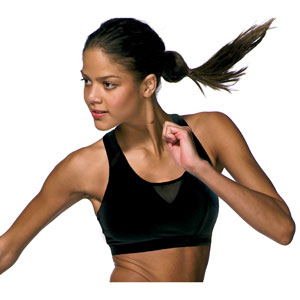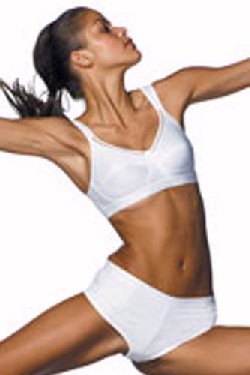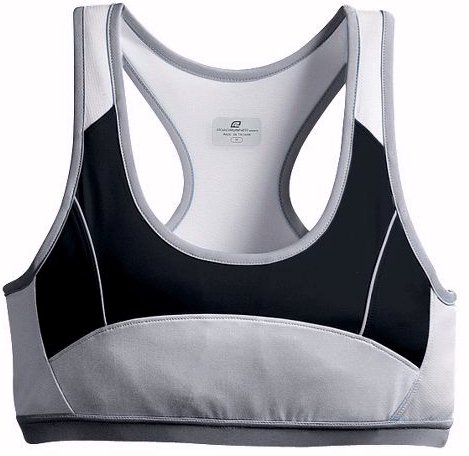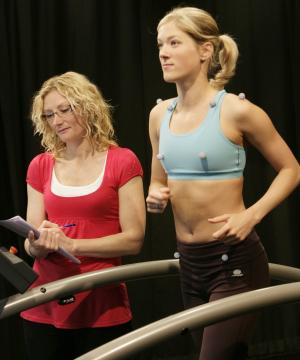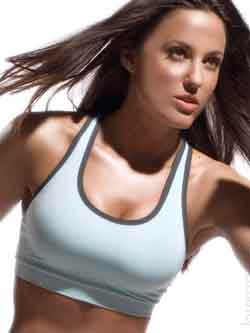| Shock Absorbing Sports Bras
The Fashion eZine - Bras & Breasts
The Ultimate Sports BraIt is difficult to make sports bras, and even more difficult to market them to women. Many women, sadly, do not exercise a lot these days. Sports bras provide firm support for the breasts, much more than regular bras. It is intended for wear during exercise that might cause the breasts to bounce around a lot, which can be quite painful. Approx. 50% of women report they have a lot of pain during exercise. By providing a lot of extra support it prevents discomfort (and embarrassment) during exercise. Sports bras are more sturdy than regular bras and offer greater support for the chest, thus increasing comfort and reducing the chance of damage to the ligaments of the chest during high-impact exercises, such as jogging, running or jumping. The first sports bra was made in 1977. Hinda Miller and Lisa Landahl cut up a pair of jockstraps and sewed them together into a bra; it was marketed as the "Jogbra". Later designs used gel and water pads, silver fibres, and sometimes even air bags. A stitchless bra was made by Wacoal, molded, compressed, and shaped. Other bras are knitted in circular patterns, giving varying stretch and support.
Types of Sports BrasThe most common design of sports bras is a stretchable, absorbent fabric such as Lycra, and is usually designed to suck perspiration away from the skin to reduce irritation. Sports bras can be classified into two major types: either encapsulation brassieres (with molded cups), or compression brassieres that restrict movement by flattening the breasts. Encapsulation is generally better for reducing discomfort; some women prefer compression designs for modesty. Quite a few women, particularly those with large pendulous breasts, find sports bras helpful for easing pain and discomfort (and embarrassment). The pain and other problems causes some women not to participate in sports that are healthy for them. Some sports bras are meant to be worn as outerwear, such as for jogging, running, gymnastics and aerobics.
Sports Bra ResearchMost bra research in recent years has concentrated on sports bras, where discomfort is directly related to the degree of nipple movement. The technology learned in making sports bras are making regular bras more comfortable and "sporty". The pain women suffer while exercising varies considerably in intensity and may depend on what kind of sports bra they are wearing (assuming they are wearing one). In an Australian study 3 women (ages 17-21, cup sizes B and C) were photographed exercising bare breasted, with two models of regular bras, and with a sports bra. As expected breast and nipple motion was reduced by bras, and the sports bra was the most effective. The women reported less discomfort with bras and almost no discomfort with the sports bra. However not all sports bras are created equal and need to be properly fitted. A 2007 British study found that breasts move in three planes of motion during exercise. This study concluded that encapsulation bras are more effective than compression bras at reducing total breast motion during exercise because encapsulation bras reduce motion in all three dimensions (vertical, horizontal and width), while compression bras reduce motion only in width. Although some women athletes are concerned that a sports bra may interfere with breathing (increased pressure on the rib cage has been demonstrated) no significant effect on breathing can be shown and many women feel they can concentrate more on their exercise because their breasts feel safe and secure.
Exercising & Sports Bras73% of women who exercise regularly do not wear sports bras. Most have never even tried one on.
They have high performance running shoes, sweat absorbent clothes and an expensive gym membership... but no sports bra. Many women apparently don't think they NEED a sports bra either. They don't realize that the back pain they are suffering is due to lack of breast support, and they certainly don't realize that they are risking injury due to torn ligaments. Here are some common myths about breasts and sports bras: MYTH: Small breasts do not need support. FACT: Even among 34As, tests found that breast movement ranged up to an average of 40mm away from the resting place of the body. While this may not seem like a lot people can still get injured if they overdo it. MYTH: There are no muscles in the breast. FACT: Female breasts are primarily composed of glandular tissue and fat, held in position by delicate ligaments. Any excessive amount of breast movement, as happens during exercise, puts strain on these ligaments and can cause them to stretch. In the long term broken ligaments means your breasts will sag.
MYTH: Specific exercises will return your breasts to their former shape. FACT: Once breasts have dropped because of stretching or tearing of ligaments, nothing short of surgery can restore them to their former position. MYTH: Running, in itself, always leads to sore and tender breasts. FACT: Inadequate breast support, coupled with excessive breast motion, is the most likely cause of sore and tender breasts after exercise. In a survey conducted by Shock Absorber, 80% of doctors agreed that with the specialist support of a sports bra, stress on the ligaments is reduced. This helps delay or prevent the long-term sagging of breasts. MYTH: Your ordinary, everyday bra is good enough to use when exercising. FACT: Tests showed that breast movement is reduced by 38% when wearing an ordinary bra but this rises to as much as 74% with a top of the line sports bra (ie. Shock Absorber).
Sports Bras & SexSome women also find they need more support during sex, finding that their breasts bounce around a lot and become quite painful during and after sex. There are several solutions: 1. Wear a sports bra during sex. (Some women wear them all the time to get the support constantly.) 2. Wear lingerie that has a lot of support.
|
|
|
Bouncing Breasts Spark New Bra ChallengeBreasts move far more than ordinary bras are designed to cope with, according to a study by University of Portsmouth scientist Dr Joanna Scurr. And they also bounce more during exercise – up to 21cm rather than the maximum 16cm bounce measured in past studies. Bras are designed to stop breasts bouncing but Dr Scurr’s study shows that breasts also move side to side and in and out. It is estimated that more than 50 percent of women experience breast pain when exercising. Significantly, Dr Scurr’s latest study also found that breasts move as much during slow jogging as they do at maximum sprint speed. She said: “This makes wearing a sports bra as important if you jog slowly as if you sprint.” Dr Scurr is working with major bra manufacturers in Britain and globally who are vying to design a bra which can lessen movement in all three dimensions and reduce much of the pain many women suffer when exercising. She said: “There really are women who want to do exercise but who don’t have the bras to cope. I know of a 16 year old who was selected to play basketball for the county but she was told to give it up because she couldn’t find a bra that made playing possible. “Breast size and pain caused by exercise can be a real barrier to women doing exercise.” But pain is not linked to the size of a woman’s breasts. An A-cup woman could be prevented from doing sport just as much as a woman with double FF-cup size. Breasts have very limited natural support and can hurt for three main reasons: tenderness during the menstrual cycle; permanent breast pain, and exercise-related pain due to stretching of the breast tissue. Dr Scurr said: “If women wore the correct form of support, if we can get that right, the use of pain medication is reduced and women can be active and lead healthy lives.
“Studies have shown that medication to reduce breast pain was only successful for 54 percent of women, but they had to put up with side effects of the medication, whereas sports bras were shown to be successful at reducing breast pain for 80 percent of women, with no side effects at all." Dr Scurr’s study disproves the previously held belief that compression bras are better for reducing movement in small breasted women and encapsulation bras better for larger breasted women. She found instead that encapsulation bars are better at reducing breast movement in women of all cup sizes. She said the big question is why we know so little about the movement of breasts. “Sports science has always been dominated by men and for them, studying breasts is seen as slightly laughable. For women, though, it’s completely credible – they can see the benefits. “At conferences when I am asked what I study I say ‘bouncing breasts’ rather than breast biomechanics. It makes people laugh nervously but they always want to know more. So little has been known about this subject until recently.” Her findings have enormous repercussions for the bra manufacturing industry and for women who want to lead active lives. Her studies have lead to invitations to work with the military, the NHS and with lingerie manufacturers. She is hoping to use cutting edge technology in 'intelligent materials' to help develop smart fabrics which can change to provide custom-made support for each woman which varies depending on the wearer’s level of activity. She said: “It is only recently that bra design has turned to science. There was no research. It’s like designing a car or kitchen equipment without first thinking ‘what is the purpose of this?’ “We need to think why do we need bras? What do we need them to do?” Seventy women were recruited for the two-year study through the university’s student and staff population, gyms and doctors’ surgeries. Those chosen represent the widest range of breast sizes ever studied including women with cup sizes DD, E, F, FF, G, H, HH, J and JJ. The glamour model Jordan has a cup size of F, six sizes smaller than Dr Scurr’s biggest breasted subject. Each woman had to undergo a programme of tests during which a wide range of biomechanical measurements were taken. Dr Scurr said: “We are building up a database on breast biomechanics which we believe is the largest in the world. “This information could be used to inform bra design, for clinical support, fundamental breast health research and to broaden understanding in this important area.”
The Physics of Bras: Overcoming Newton's second law with better bra technologyBy Anne Casselman One side effect of the obesity epidemic in America is rarely noted: Women's chests are expanding nearly as fast as their bellies. Poor eating habits, as well as breast implants and the estrogens in birth-control pills, have led to an increase in the past 15 years of more than one bra size for the average American woman—from a 34B to a 36C. For many women, this has been a burdensome trend. A pair of D-cup breasts weighs between 15 and 23 pounds—the equivalent of carrying around two small turkeys. The larger the breasts, the more they move and the greater the discomfort. In one study, 56 percent of women suffered from breast pain when jogging. "Women will limit themselves from doing exercise because of their breasts," says Deirdre McGhee, a sports physiotherapist and graduate student in biomechanics at the University of Wollongong in Australia. "They actually deprive themselves." And the less they exercise, the more obese and buxom they may become. For most women, a good bra is still the best remedy. According to the American Apparel and Footwear Association, nearly 500 million bras were sold in the United States in 2001; last year, sales totaled more than $5 billion. As breasts have grown, so have the demands of customers, the scientific sophistication of bra design, and the competition among bra manufacturers. "Women like their bras to be sexy and sensual and comfy and supportive," McGhee says. "And to get all that is rare." Yet after nearly a century of experimentation, the perfect bra may well be in sight. Bra designers begin with a significant handicap: The structure of breasts is still something of a mystery. Evolutionary biologists aren't sure why breasts evolved as they did—chimpanzees and other mammals develop them only when lactating—and no one knows what keeps them from sagging. An individual breast is made up of between 15 and 20 sections, known as lobes. These are composed of smaller lobules that end in bulbs that produce milk and are interconnected by a network of ducts. But breasts contain no muscles at all, and the bulbs and ducts are essentially the same in all women. Size is mainly determined by how much fat the breasts contain. Most anatomists believe the breasts' primary means of support are the Cooper's ligaments interlaced among the lobules. But others give the skin more credit. To best support breasts, a designer has to understand how they move. To that end, McGhee's team in Australia, headed by biomechanist Julie Steele, tags women with light-emitting diodes and asks them to run on treadmills. (The women run with and without bras, so the laboratory doors are bolted to prevent uninvited people from bursting in.) Computer systems then track the breasts' motions in three dimensions by following the moving lights. "We can actually work out exactly where they're going, how they're moving, and how this movement is affected by bras," Steele says. Breasts move in a sinusoidal pattern, Steele has found, and they move a lot. Small breasts can move more than three inches vertically during a jog, and large breasts sometimes leave their bras entirely. "We have videos of women who, particularly if the cup is too low, spill all over the top," Steele says. The larger the breasts and the more they move, the more momentum they generate. To change or stop that momentum requires a large force, usually applied through bra straps. When straps are thin, the pressure exerted through them can be so great as to leave furrows in the shoulders of large-breasted women. As the straps dig into the brachial plexus, the nerve group that runs down the arm, they may cause numbness in the little finger. In some cases, breasts can slap against the chest with enough force to break the clavicle. "Force equals mass times acceleration," Steele says. "That's Newton's second law. You have a large mass, and it's going quickly, and the force is going to be large. If you have breasts that are slapping down and hitting the chest and having to come back up, they accelerate very quickly." No one really knows the long-term medical consequences of "excessive breast bounce," as Steele calls it. But it can cause pain and is the most likely reason for sagging breasts. There are two ways to keep breasts from moving: encapsulation and compression. Encapsulation bras look like the old-fashioned brassieres our grandmothers wore, with large molded cups that completely contain the breast. Compression bras are more popular but less comfortable: They squash the breasts against the body, thereby reducing the amount of weight the bra has to cantilever. Since the 1800s, when women used corsets stiffened by whalebone to support their breasts, bra designers have experimented with innumerable structures and materials. "Making a bra is like building a bridge," says Manette Scheininger, a senior vice president of design, merchandising, and research and development at Maidenform. "You have weight that has to be uplifted. You have to have support all around." Larger breasts compound the challenge, Scheininger says. "And not just by a little bit. The challenge grows dramatically." The first sports bra was created in 1977, when two American women took a pair of jockstraps, cut them apart, and sewed them back together. They dubbed their creation the Jogbra. Other bra designs since then have used gel and water pads, silver fibers that cool the skin and dispel bacterial growth and body odor, and air bags that wearers can pump up to enhance the appearance of their breasts. This past summer, a virtually stitchless bra was introduced by Wacoal, a leading manufacturer. The bra is molded, compressed, and shaped at the same time—"sort of like a car fender," Wacoal designer Linda Hyde says. Thanks to cylindrical hosiery machines, other bras can now be knit in circular patterns with differing amounts of stretch and support. To track the motions of women's breasts and find better ways to support them, biomechanists in Austrailia fit subjects with specially designed bras. In back, sensors are placed under the straps to measure how much pressure they exert on the shoulders, and electrodes are placed on the upper torso and the neck to monitor the bra's effects on muscle activity. Small, light-emitting diodes are placed in front of the sternum, nipples, and bra cups to measure the subject's breast and torso movements. Steele's team is taking fabric technology another step. Six years ago, her laboratory, in collaboration with the University of Wollongong's Intelligent Polymer Research Institute, began work on the world's first smart bra. It uses intelligent materials and electronic textiles to sense when breast motion increases and tighten appropriate parts of the bra in response. "When you're sitting around the office, it isn't restrictive," Steele says. "But if you need to run for a bus or something, it will sense that you've started to run, and it will give you the support of a sports bra." Steele's lab has teamed up with Marks & Spencer, a major retailer in Britain, to further develop the project. Meanwhile, McGhee and Steele have their sights set beyond tinkering with bra straps and fabrics. They are using Steele's extensive work on the biomechanics of breasts to explore an entirely new way of designing bras. Starting in the 1970s, podiatrists and biomechanists radically redesigned running shoes to make them lighter and more stable. Steele and McGhee hope to accomplish a similar paradigm shift and correct the problem with the most supportive bras: They are also rated the most uncomfortable. "We're not testing a product but a concept," says Steele. "What we're trying to bring in now is an idea that will not be a gimmick—understanding the structure, function, and the movement and putting them all together with the science underpinning it." Steele and McGhee are reluctant to divulge any details for fear of tipping off rival designers—"It's a really dirty game," McGhee says. But initial trials are under way while they stake out intellectual property rights. Given that more than 30 percent of American women now wear D cups and larger, the team shouldn't have trouble finding a commercial partner if they succeed. When it comes to bras, the usual rules of exercise are reversed: No pain, very much gain.
| |
